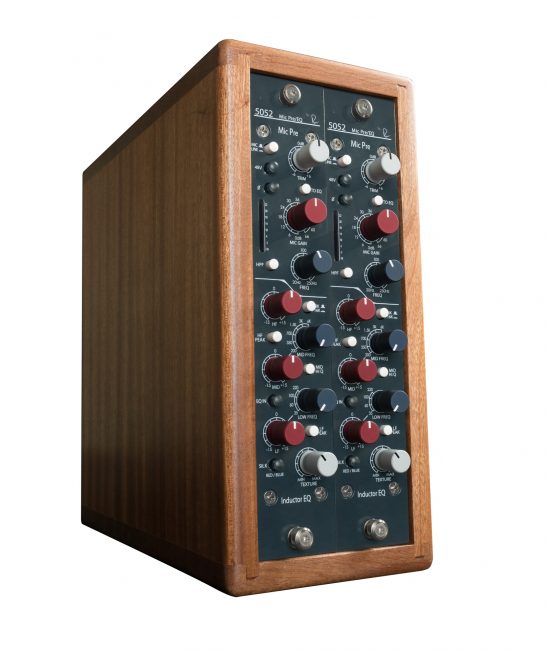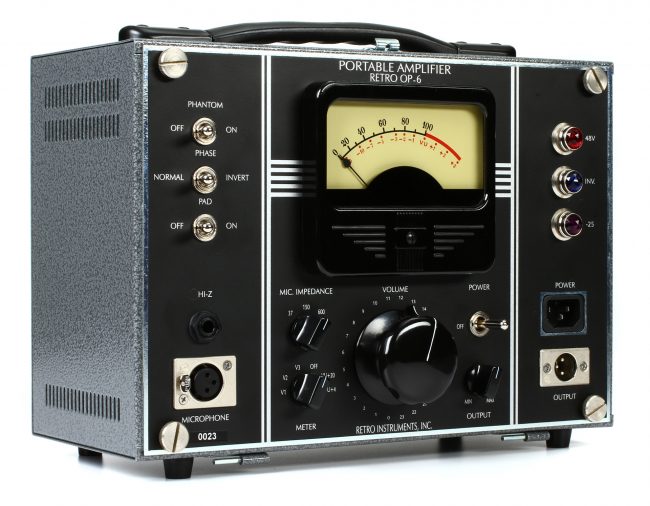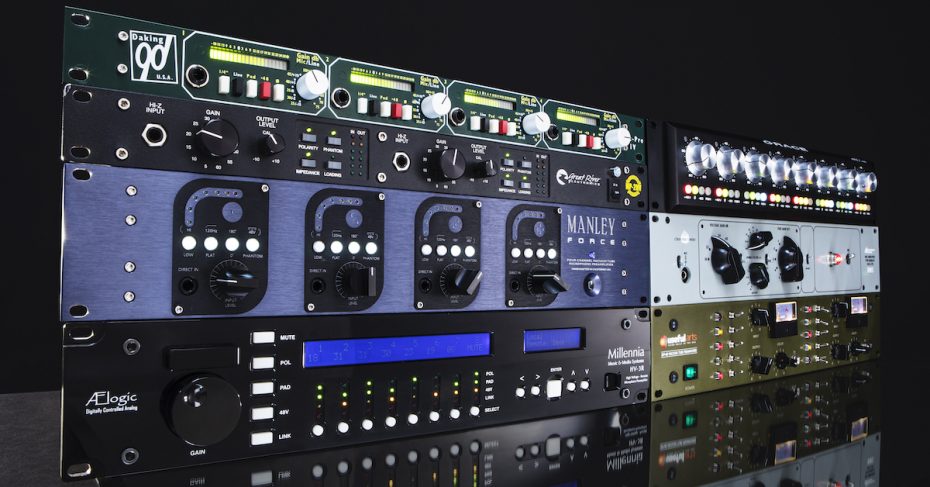
The microphone preamp is a critical component in your recording chain, and its impact on the sound is profound. If you’ve ever wondered why people spend so much money on boutique preamps, here’s why.
What Is a Mic Preamp?
But what is a mic preamp? The mic preamp is the first thing your microphone plugs into. So, if you plug a mic into the back of a console or into your interface, the preamp is what the mic signal encounters first. The preamp provides the amplification (gain) that boosts the mic signal up to a line level so it can be processed by EQs, compressors, limiters, etc. It’s a necessary step in any audio chain, but, since it’s so common, its impact can easily be overlooked. But if there are already preamps in everything, why would anyone want a “boutique” preamp?
Have you ever looked around at high-end preamps? Maybe you’ve looked through Sweetwater’s site searching for high-end preamps or searched online for preamps whose names include “1073,” “1066,” “1084,” “V72,” or “V76.” The prices you’ve seen may have shocked you. There are preamps out there that may cost more than your whole studio! And not just vintage gear, either. You can easily spend four figures on a single-channel preamp. If you’re new to the recording game, you may ask yourself: “How in the world can a box that provides only gain cost so much?” And why does it matter that a preamp is handwired with select components at incredibly tight tolerances (the very definition of “boutique”)?
The Most Important Thing
Ultimately, it all comes down to one thing: sound. Sure, there are other factors that affect the perceived value of a preamp (like history and rarity), but it’s all about the sound. If you’ve never had the chance to get your hands on a high-end preamp, I’m here to tell you that it can change your life. If you’ve never plugged a mic into a preamp and had that “AHA!” moment, you need to experience that.
It’s the day you’ll discover why all those classic records sound so good and why the stuff you’re recording doesn’t quite measure up. For me, that was in 1987, when I bought the first ever Rupert Neve-designed Focusrite ISA-110 preamp/EQ modules in Nashville. Focusrite was a brand-new company with Rupert Neve, the preeminent console designer, at the helm. These two modules were a huge investment even then (in 2020 dollars, it would be approximately $17,000!), but the first time I plugged in a mic and listened to what they did, I knew it was worth every penny. (That was 33 years ago, and they are still sitting an arm’s length away from me now as I type with Rupert’s own hand-signed inscription on them.) I will never forget what a huge impact they had on my sound. I wanted to go back 10 years to the beginning of my career and re-record everything I had ever done. Honest.
Other Considerations
Sure, the sound is paramount, but there are other considerations, as well. A high-quality preamp is an investment — think of it like a craftsman’s tool that will be used your whole life and then passed on to another craftsman. Believe it or not, there are preamps that have been used to make hits for over 70 years now by multiple generations of record makers.
Value is another factor — the right tool may increase in worth even after decades of service to you. Reliability is important because you need a tool you can depend on, day after day and year after year. So, choosing the right preamp is a value proposition for anyone who is recording because it impacts every recording you make.
I suspect it shows, but I’m passionate about preamps. I’ve lost count of how many I’ve auditioned over the past few decades. Apart from microphones, there’s nothing that will have a greater impact on the sounds you record.
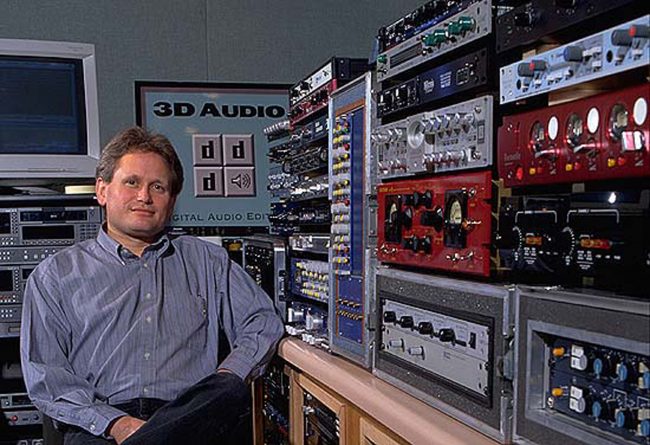
So, when the subject of “Why do boutique preamps cost so much?” comes up, I know the answer: “Because they’re worth it.” I’ve had this same discussion with dozens of preamp designers throughout the years, so I reached out to some designers and asked them the same question.
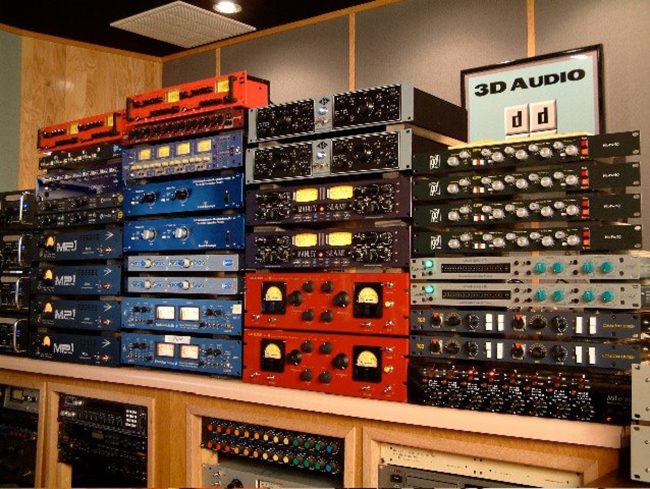
API (Automated Processes Incorporated)
The folks at API have been making some of the world’s best-sounding preamps and consoles since 1968, when the company was founded by the late Saul Walker. You’ve heard API preamps on hundreds, probably thousands, of hit records from the ’70s to today. They are exceptional tools that provide a very unique and desirable sound. I called API Director of Sales Dan Zimbelman and asked him why API preamps are so expensive.
Dan: “Well, first off, they really aren’t that expensive. The best preamps represent excellent ‘value for the money.’ If you want proof of that, just look at the typical resale value of high-quality preamps and consoles like API. They offer long-term value, far greater than less expensive alternatives. They have a very long, useful life. There are lots of API products from the ’70s that are still in service today.
“The parts we use in API mic pres are extremely high quality, and you can see that in the key components — op amps and transformers. A chip-based (IC) electronically balanced circuit can cost pennies compared to the far-more-expensive discrete analog op-amp transformer designs we use.
“While some think that small-volume production costs more, it’s not that large a factor for API. All our mic pre designs use the same quality components. So, even though we have over a half dozen different models, we build those components in large quantities to keep the cost down.
“API’s supply chain is largely domestically based. We source some parts from offshore that are just not available anywhere else, but our proprietary parts are made domestically. That’s more expensive, but it’s been a positive during the COVID-19 shutdown because we’re not waiting for inventory from overseas. We have product, and we can ship.
“Reliability is something that cannot be stressed enough. At API, we stand behind the build quality of our products with a 5-year warranty on all parts. We can do this because of the consistently high quality of our components. And we’ve been building preamps and consoles for over 50 years. We know how to build preamps that last.”
Manley
If you’ve been to a recording trade show or a hi-fi show anywhere in the world, then you’ve likely crossed paths with EveAnna Manley, the colorful leader of Manley. When she’s not building some of the finest audio gear in the world, she’s likely trekking across Asia with a group of motorcycling adventurers. I’ve known EveAnna for years, and I know her passion for audio — and tubes! “Tubes Rule” is her slogan, and it’s emblazoned on bandanas (how timely) and T-shirts along with the Manley logo. Manley gear is ranked at the top of the most desirable pieces of recording gear in the world, but it’s not cheap! There’s a reason for that. So, I asked her how she continues to make what many would consider to be “future classics” and to sell them for top dollar.
EveAnna: “Well, for one, our gear is all built in Southern California, or as we like to say, ‘Made in Chino, not China!’ These products are built by American workers, many of whom have been with us for decades. And we take care of our people. In turn, they will take care of you, too!
“The parts and materials that go into every Manley unit are chosen on sonic contribution and reliability. Parts cost is the third factor. There are so many brands of parts that we have been loyal to for decades because their reliability has been solid. Important American-made brands include Cornell-Dubilier and Reliable Capacitors and Grayhill switches. Bourns potentiometers and WIMA capacitors are also not made in China, and reliability is absolute with those brands. Our faceplates and casings are made locally with American metal. We hand finish each part and drive them personally to local anodizers and powder-coating operations. We wind our transformers in-house, and all the materials for our magnetic components are sourced from the USA.
“So, the real bulk of cost put into any Manley product has been spent in the USA with American materials, supporting our local workforce and communities. That’s just more expensive than having things built for us overseas, and that’s a choice we made.
“Vacuum tubes themselves have skyrocketed in cost over the years, as they are incredibly labor-intensive to manufacture. They are very specialized devices, and only a handful of vacuum-tube factories remain active in the world today. There are no American factories that make a common 12AX7 anymore, for instance. In some cases, we have been lucky to uncover large stashes of NOS (New Old Stock) parts decades ago, and we invested and stockpiled those tubes. There could have been more lucrative investment vehicles — such as real estate or stock market investments — for us, but those would not have sustained decades of production with rare, awesome-sounding vacuum tubes!
“When dealing with vacuum-tube circuits, so many associated parts are not ‘cheap,’ such as audio transformers; large-value and high-voltage film capacitors; and specialized, proprietary multi-rail power supplies. Additionally, development of each product takes many months, or sometime years, by a team of experienced engineers who create, prototype, and develop it into a buildable and salable production product. We do all of that here in SoCal.
“So, while customers may see Manley products that are beautifully machined and look gorgeous, inside you’ll find a chassis chock-full of audiophile-grade components. Not visible to the naked eye, there is a ton of engineering that goes into every unit’s development, production, evolution, and propagation; and on the back end, we’re devoted to providing responsive after-sales service and warranty support.”
Rupert Neve Designs
I reached out to Dennis Alichwer, Engineering and Operations Manager at Rupert Neve Designs, and asked him to share his thoughts on RND’s commitment to absolute sonic quality. “Rupert Neve Designs’ products are developed with passion for music and the enhancement of artistic talent at the forefront. Although component costs must be considered in each design, no compromises in audio quality or performance are ever permitted in Rupert Neve Designs products. Capturing the best-quality sound works to not only enhance the artist performance but also boosts the engineer’s credibility.”
Dennis offered this list of specifics that apply to RND preamps — things that make them legacy tools that will live on for future generations. Those include:
- Our products are proudly “Made in the USA”
- We use military-grade rotary stepped-gain switches for highest reliability and long life
- We utilize custom transformer-coupled outputs for ground-noise-free operation, fully variable for modern to vintage sound
- Transformer-coupled or equivalent-circuit inputs optimized for best common-mode noise rejection
- Ultra-wide-bandwidth circuit performance far beyond the typical audible range for maximized sound quality
- Discrete component designs for lowest noise performance
- Low-noise phantom voltage supplies optimized for best overall noise performance
- Unique features that you won’t find on other preamps, such as variable Silk, dual-tapped transformers, etc.
- High-voltage audio circuit operation for added headroom, significantly higher voltage than “value-oriented” products. The higher-voltage power rails we use add 4–5dBu in headroom compared to 12V or 15V rails.
- High-grade/high-reliability components throughout, carefully selected for each circuit
- Tightly controlled input and output EMI filtering for noise-free operation in any environment
- Robust mechanical designs for high reliability and long product life — to withstand the rigors of touring and travel
- Thorough sonic evaluation for each and every design sub-section with extensive listening tests
- Robust circuit designs that protect from static discharge for ultra-high reliability
- Class A circuitry throughout for lowest distortion
- Worldwide operation assured with highly reliable universal-input power supplies
- Superior quality Neutrik-brand connectors for reliable I/O connections
Great River Electronics
I’ve known Dan Kennedy, founder of Great River Electronics (named for the great Mississippi River on which he lives — in a houseboat), for several decades now. He’s a no-nonsense, down-to-earth guy who values quality and functionality over flash. The same is true of his very industrial-looking preamps. They aren’t sleek and shiny, but they sound amazing. They’re quality tools that will perform reliably for years. Honestly, when I’ve done shootouts, the Great River preamps sound better to me than lots of “big name” preamps that cost lots more because of the brand names on the front.
I was moderating a preamp designer’s panel in Portland a few years ago when someone in the audience asked the designers if they could build a preamp that costs $200 instead of $2,000. Dan’s reply was classic, and I’ve never forgotten it.
Dan: “Well… there’s more than $200 worth of transformers in an MP-2NV — that’s my cost when I purchase in quantity! So, for $200, I can’t even sell you the transformers, much less the gain switches, pots, connectors, power supply, and everything else in the box. All those passive components are high-quality, expensive parts. And then there’s the design work and the construction. It all adds up to a product that sounds great and will last a long time. But you simply can’t build that for $200.”
When asked about the design philosophy at Great River, Dan says:
“I feel it’s important to make a high-quality tool that a craftsman can get to know and then count on forever. It needs to be rugged so an accidental mishap doesn’t damage it. Operating controls need to be accurate, easy to see and set, and ensure a long life. Internal components are chosen for stable performance over an extended lifetime. This all points to industrial- or military-grade construction and components, which are much more expensive to buy and stock. The benefit is reliability. There are NVs that are coming up on 20 years of service now, and our older preamp models go back to the early 1990s; and they’re still chugging along, fetching more on eBay now than when they were new.
“Many folks don’t know this, but our background is building passenger- and freight-elevator control systems for several companies, and we also build fluid control systems for the semiconductor industry. Needless to say, those are industries where reliability and longevity [are] paramount. Those same qualities guide the design and construction of our Great River MP-2NV, ME-1NV, and MP-500NV 500 Series preamps.
“We’re a small shop, not a huge company, so we fit the description of ’boutique’ well. We all wear many hats, but the same knowledge, experience, and attention to detail [go] into all of our products.
“And if a problem shows up with anything we made, there’s a good chance that I will personally fix your unit; I like to be hands-on in every aspect of the business.”
Retro Instruments
The Retro Instruments OP-6 (shown above) is not a preamp that was built to a price point — and it shows. It’s the result of one man’s passion for classic circuitry and improving on vintage designs. That man is Phil Moore, owner of Retro Instruments. While it’s the most expensive single-channel preamp that Sweetwater currently offers, it perfectly illustrates the point that high-end preamps cannot be cheaply made. To me, the OP-6 is like a work of art where no expense was spared to make it the best it can possibly be. Years ago, I heard the first prototype and compared it directly to an incredibly rare and valuable original RCA OP-6 that was built in 1947. I can tell you that the Retro OP-6 is unlike any other preamp I’ve ever heard. So, I asked Phil what makes it so expensive to manufacture this preamp.
Phil: “Like most vintage pieces from the earliest days of recording, the OP-6 is all handwired point to point. That’s expensive compared to modern production techniques, but it makes a clear sonic difference instead of using miniature traces on a PC (printed circuit) board. Then, there’s the development cost. You have to amortize the cost of researching/building/developing a piece of gear over the number of units that you expect to sell. If I was selling tens of thousands of these, then that cost per unit would be drastically lower. But I’m not, and I never expected to. I did this because I loved the way that the original OP-6 sounded and I wanted to re-create that [while] including modern conveniences like phantom power, polarity switching, pad — and I was also able to make the circuit quieter.
“Our cost includes selecting NOS tubes that spec among the best; a steel chassis with a beautiful hammertone finish made in California; US-made transformers; a classic, US-made VU meter; plus, burn-in and testing by our top technician. And we will cover any defect in workmanship if you can get the unit back to us. We’re not a one-man shop operating out of a garage, but we’re also not a huge corporation. We’re dedicated craftspeople making fine instruments for people who want to make great-sounding records. And we’re committed to our customers who appreciate that.”
In Closing
Maybe you’ve heard the quote “A poor workman blames his tools.” The opposite of that is “A smart workman is inspired by his tools.”
Ask anyone who is passionate about a craft, and they’ll tell you there is no substitute for great tools, whether you’re into woodworking, photography, music, etc. They make your job easier. They give you peace of mind. And they make you look better.
Someone asked me once how it was possible for me to work so fast in the studio. I glanced to my rack of external preamps and said, “If you have the right tools — like the right mic through the right preamp — then you’re 90% of the way there. With the right tools, it’s easy. And fast.” When it comes to preamps, my hope is that you get that one or those two (or dozens of) preamps that allow you to realize the sounds you want to hear. When you have a premium preamp, such as the ones discussed here, they will make your life so much better. And your recordings, too.
If you want to elevate the quality of all your recordings, call your Sweetwater Sales Engineer at (800) 222-4700 and let them help you find the right preamp(s) for you.




